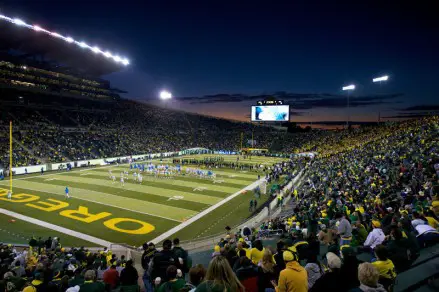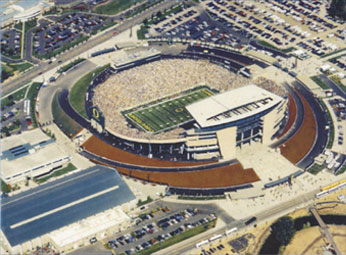 Every September fans pile into the magnificent stadium that is home to the Oregon Ducks football team. Students take the mile or so walk to Autzen Stadium and get hyped up, as they enter into what some consider the loudest stadium in the nation. Autzen has come a long way, from season after season of unwatchable football, to hosting the inaugural PAC-12 Championship game in 2011. From Jerry Frei to Mark Helfrich, Autzen has housed some of top offensive minds in the game.
Every September fans pile into the magnificent stadium that is home to the Oregon Ducks football team. Students take the mile or so walk to Autzen Stadium and get hyped up, as they enter into what some consider the loudest stadium in the nation. Autzen has come a long way, from season after season of unwatchable football, to hosting the inaugural PAC-12 Championship game in 2011. From Jerry Frei to Mark Helfrich, Autzen has housed some of top offensive minds in the game.
The Ducks originally played their home at games at the notorious Hayward Field, known for being Steve Prefontaine’s battleground. Hayward Field began hosting football games in 1919. The field was said to not be an adequate football stadium; it did not house many people, and the seats were not comfortable. Hayward, as beautiful as it is now, was nothing like it was in the 50’s and 60’s. Due to large crowds, the Ducks had to play their bigger games two hours away at Multnomah Stadium in Portland. This was a nuisance for fans and players alike, who wanted to play every game in Eugene. Plans were set in place to construct a stadium that fit the criteria of a powerhouse college football stadium.
Leo Harris, the first athletic director in Oregon history, began setting plans in place during the 50’s. Harris is known for having a personal relationship with Walt Disney, and acquiring the rights to the Duck mascot, known as Puddles. The stadium was set to be constructed on 560 acres that the school has previously acquired because of Harris’ idea. Construction began in 1966, and nine months later was complete. Just like that, Oregon had a brand new facility. The total project cost $2.3 million dollars. $250,000 dollars of it came from the Autzen Foundation, cementing the stadium name. Ironically, Thomas John Autzen, the foundation’s founder and plywood company owner, was an Oregon State alumni, and his son Thomas E. Autzen who took over the family  business, graduated from Oregon in 1943.
business, graduated from Oregon in 1943.
The first game was played in Autzen on Sept. 23, 1967. The Ducks waddled into their new stadium amazed at what was built in a mere nine months. The new facility had a capacity of 40,000 and featured natural grass as the playing surface. The Colorado Buffaloes were the Ducks first opponent on that cool September day. Despite all the excitement coming into the season with the new stadium the Ducks fell to the Buffaloes 17-13. Oregon had to wait nearly a month before they could claim their territory, getting their first win in a rout of Idaho, 31-6.
The stadium went nearly 20 years without any significant renovations, until 1988, when $2.3 million was used in the construction of the new skyboxes. Eleven individual skyboxes were built along with a 460 seat super suite. In 2002, Autzen underwent another super renovation. $90 million dollars was spent on this occasion, and the stadium was completely rejuvenated and revamped. Field turf was installed, and remains the Ducks current playing field. Seating and luxury boxes were added to the south sideline. Other renovations included improved accessibility and new concessions and restrooms facilities. The new capacity was 54,000 and stands at that total today.
Numerous traditions were born in Autzen, and remain to this day. In 1990, Don Essig, the stadium’s PA announcer, first coined the phrase “It never rains at Autzen Stadium,” and it has stuck ever since. No matter how cold or wet it gets in Autzen, it remains dry by Oregon standards. The 1978 film National Lampoon’s Animal House has also incorporated itself into the Autzen stadium  tradition. In the movie which takes place on the University of Oregon premises, a toga party is thrown featuring the song “Shout”. Thus at the end of every 3rd quarter, The Isley Brothers and the toga party scene from the movie appear on the “jumbotron”, and everyone in unison sings the song and dances to it. The Ducks mascot completes push-ups for every point scored providing for an intense work out when the flying and speedy Ducks put up 50 plus on the board.
tradition. In the movie which takes place on the University of Oregon premises, a toga party is thrown featuring the song “Shout”. Thus at the end of every 3rd quarter, The Isley Brothers and the toga party scene from the movie appear on the “jumbotron”, and everyone in unison sings the song and dances to it. The Ducks mascot completes push-ups for every point scored providing for an intense work out when the flying and speedy Ducks put up 50 plus on the board.
Although the man’s name isn’t on the stadium, Leo Harris does deserve a lot of the credit. He was a force behind the construction of the greatest stadium in college football. Autzen Stadium does lay on Leo Harris Parkway, so look up the street sign the next time you pass it and thank the man. Mark Helfrich not only gets to take over a great team, he gets to play in perhaps the loudest stadium in the country. The 2013-2014 season may be one for the record books as De’Anthony Thomas and the team are looking to finish the “unfinished business” Chip left them with. Hopefully this year Autzen Stadium will host the Pac-12 Championship and the Ducks can cement their name as the last team to win the National Championship before the playoff system begins.
Related Articles:
Get Realistic: Oregon is not "Elite" and Won't be Again
Can Non-Alumni Be Better Oregon Fans? Duck Family Day!
Put Down Your Pitchfork: Oregon Born, Duck Raised, Husky Alumnus?
Duck Family Day: Growing up a Duck in an Agnostic Family
From Sleeping to Screaming: a Football Journey
Have You Ever Cried After a Duck Game?
These are articles where the writer left and for some reason did not want his/her name on it any longer or went sideways of our rules–so we assigned it to “staff.” We are grateful to all the writers who contributed to the site through these articles.
